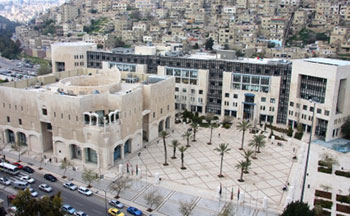 Municipality of Greater Amman
Municipality of Greater Amman
Municipality of Greater Amman

General Information
About Gam History
Vision
A Leading Municipality to make city of Amman Organized, modern, smart, safe, attractive, with a soul, friendly and livable, proud of its heritage and authenticity.
Mission
To Provide high quality municipal services of excellence focused on the environmental , health , organizational and infrastructure dimensions while maintaining the identity of the City of Amman , cultural heritage , Community Development and concern of the human dimension through good planning, optimal investment of resources and building partnerships with stakeholders.
Values
E-KIT & DISC
1.Commitment to Service Excellence
2.Learning and Knowledge Transfer
3.Integrity, Fairness and Transparency
4.Teamwork
5.Belief in Change , Development and Continuous Improvement
6.Ensuring the Participation of Stakeholders
7.Encouragement of Innovation, Initiative and Creativity
Gam About Amman
The history of Amman starts from the village of Ain Ghazal that originated the oldest civilizations in the stone era dates back to 7500 BC.Modern excavations, conducted in 1974, found the tombs of human and animal statues, all indicate a stable agricultural civilization in the material and spiritual terms. Following, the most important historical periods that have passed on Amman: -
Ammonites state Amman capital of headquarters of the Ammonites. And the remains of Ammonites palaces still fresh in the Citadel, including walls, fences, and wells drilled into the limestone rock. In the Citadel, the four statues of the kings of the Ammonites were found dating back to the eighth century BC, and named after the goddess of Ammon (King’s House).
Greco Era: Amman witnessed control of the Ptolemies, Ptolemy II in 285 BC, who namedAmman Philadelphia (the City of Brotherly Love) instead of Rabbat Ammon by the commander Philadelphus.
Roman and Byzantineera 63-636 AD, the Byzantine left a church on both sides of the middle corridor in Amman Citadel and the city became part of the Decapolis, a coalition was composed of ten cities today are located in Jordan, Syria and Palestine.
Islamic Era: the Army of YazeedibnAbiSufyan inaugurated Amman, ending the state ofGhassanid controlling Balqa that Amman was part of.
Umayyads Era: the Umayyads built a large mansion on Citadel, and Amman became an administrative center.
Abbasid Era: Koorat Amman (the administrative center) witnessed battles where the walls and forts were destroyed in an internal military confrontation.Historians refer that the Abbasids fortified in Amman when someUmayyadserupted demanding succession in the reign of the Caliph Mamoun bin Rashid.
Fatimid Era: Amman was in the era of the Fatimids the center for assembling troops, but at the end of their rule in the 11th century, theexternal pressures coming of the Crusaders began, and it was mentioned in the history that the year 1184 SalahAddin passed in Amman on his way to Karak, becoming at that time part of the state Ayyubid.
MamlukEra: Amman witnessed stability andmarkets flourished in the seasons of Hajj, but it then entered oblivion and neglectuntil the end of the nineteenth century.
Ottoman Era:As.SadrAl.Aazam Kamal Pasha 1832 - 1913 suggested at the Porte in 1878 to use the state of Amman (or MaamouratAl.Hamidiyah) within the adjusted administrative divisions in Syria, but his proposal was not implemented though its demonstration of the importance of Amman in that era. The mostdistinguished achievementof the Ottomans in the history of Amman is the construction of the Hejaz Railway, which was passing in Amman and contributed effectively to the renaissance of the city and recovered from its long hibernation at the end of the age of the Ottoman Empire, during the reign of Sultan Abdul Hamid II.
Amman nowadays
The years 1867, or 1878 (as recalled by some historical references) Amman received the first Circassian immigrants, who setteledin Ras Al Ain, where the so-called immigrant neighborhood was reffered to them.A few years later, Chechnya and Armenians followedCircassians in immigration. Within the Great Arab Revolt,free Arabs came there, and Ammanbecamethe capital of the emirate of Transjordan by the arrivalof Prince Abdullah Bin Al-Hussein in 1921, thenthe capital of the Hashemite Kingdom of Jordan in 1946.
Theemerging city attracted a large number of families from different Jordanian, Syrian, Palestinian and Hijazi cities. The city also received refugees’waves from Palestine starting from the 1948 war and during the 1967 war and the war of the occupation of Kuwait, where life began to change dramatically in Amman as a result of the dramatically large increase in the number of its population.
Down town Stands as the old central region of the capital of Jordan witnessing the history of the modernity of the city, and the most distinguishing feature of this downtownis the old markets, especially the Yemeni, Bukhari, andHamediamarkets.The downtown is situated among a number of archaeological sites, particularly the Roman Citadel and amphitheater, which highlight Jordan's historic landmarks.
Amman’s contemporary urban history is populated, back to the last quarter of the nineteenth century (1878), the history of the municipal starts since (1909), in the formation of the first municipal council which, following the Provincial authorities in As.Salt. This council was established under the law of the Ottoman States issued in 1870 (17 Ramadan 1294 AH), and (Ismail ArslanBabouk) was the first Mayor of the Municipal Council in Amman
In the Fourth decade of Amman Municipality,the number of the city's population increaseddramatically for several reasons, including: the end of World War II and the start of the stability of the region and country (1945), the independence of the country, and theannouncement of Amman as the Jordanian capital of the Hashemite Kingdom of Jordan (1946).
In 1949, the municipal council's decided to expand the boarders of the Municipality of Amman (1949). The city took beauty and zoning processeson a large scale.
In the sixth decade in the life of the capital, the population jumped in Amman from (4.217) thousand at the beginning of the decade (1959/1960), to (461) thousand at the end of (1969). The zoning area of the city increased from 57 km2 in the beginning of the decade to (3.86 km2).
In the ninth decade, the population continued to increase reaching at the beginning of the decade (5.1) million, and rose at its ends to about 1.8 million (1999), because of the return of thousands of citizens working in the Gulf countries, especially Kuwait. The area of the cityincreased, arriving at the end of the decade to about 670 km2, where the boarders of the municipalityhas expanded and witnessed what could be considered as a "revolution" on the level of infrastructure, especially to solve the problem of basic traffic junctions in the capital. Manytunnels and bridges wereestablished, as well as continuedroadspaving,andadding neighboring municipalities to become within the boundaries of the city of Amman.
The area of Amman now is 799.93 km2 and the total population, according to 2015Census reached (4) million.
Working Hours :
From Saturday to Thursday
Daily: 8:00 AM – 3:30 PM
Thursday: 8:00 AM – 2:30 PM
Friday is an Official Holiday Greater Amman Municipality's employees
Contact Information
- Website
- http://www.amman.jo/
- Fax
- 0096264649420





